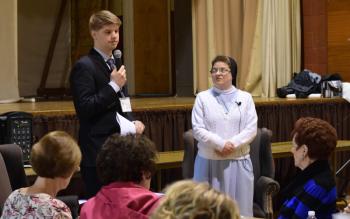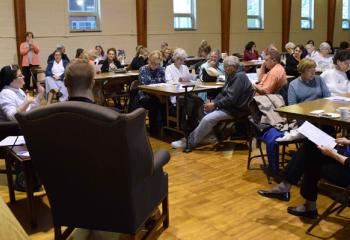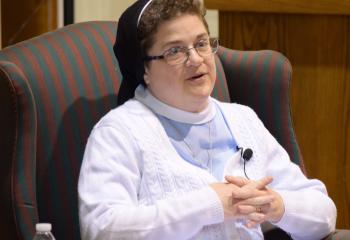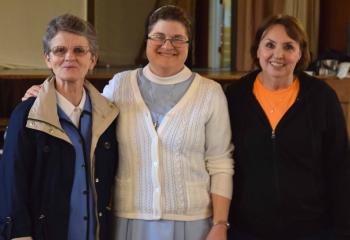By TARA CONNOLLY Staff writer
The Blessed Mother is considered one of the greatest Catholic saints, who does not desire to be worshiped and is considered the “Queen of the Heavens” – even though her spouse was not a king.
Those were a few of the facts Sister Emily Vincent shared May 16 during the series “What the Catholic Church Really Teaches.” She is director of religious education at the combined program of Our Lady of Hope and St. Patrick in Northumberland County.
Sister Emily led the informal discussion and fielded questions from Rick Dooley, assistant director of the Diocesan Office of Adult Formation, at St. Joseph Hall (Annunciation BVM Hall), Frackville.
Sister Emily opened the discussing by telling the estimated 40 faithful that to have a loving relationship with anyone – including the Blessed Mother – one must develop a relationship with the person.
“We get to know others by talking to people who know them best. In the case of the Blessed Mother, Matthew, Mark, Luke and John knew her best. It is so important to reflect on what they say about her,” she said.
While describing Mary, Sister Emily said she was around 12 to 14 years of age when the Angel Gabriel appeared to her and told her she would bear a son.
“She was greatly troubled and asked ‘How can this be?’ The angel told her that the Holy Spirit will come upon her. She asked no further questions,” she pointed out.
According to Sister Emily, Mary is “relational” because she immediately set out to see her cousin Elizabeth, who was pregnant with John the Baptist after many years of being barren.
“We should always ask God to reveal people like that to us. God is always placing people in our lives,” she said.
Sister Emily also maintained that Mary “trusted in God” in her poverty and humility by giving birth to Jesus in a stable and fleeing to Egypt to protect his life.
“We have to remember like Mary – to trust in God. We need to trust in her, too. Go to her and ask for her help and protection,” she advised.
When Jesus disappeared for three days to the temple and when the Wedding of Cana was in peril, Sister Emily pointed out that Mary did not have all the answers and was always willing to “pitch in.”
“She had no idea he was at the house of his father. And when Mary saw an embarrassing situation at a wedding – she went to her son,” she said.
“How many of our mothers sent us out to help a neighbor who was struggling? She still intercedes for us on our behalf. Mary wants to pray for us and help us when we are struggling. God gave her to us as our mother. God wants her to help us,” said Sister Emily.
As to whether Jesus had siblings, Sister Emily pointed out that it was unlikely since Jesus gave her to his disciples while dying on the cross.
And although the Gospels and Scriptures use the Greek word “adelphos” meaning “brother” whenever there is a mention of Jesus, Sister Emily said there was not a comparable English word, and at that time the word often referred to uncle, cousin or nephew.
“Adelphos doesn’t necessarily mean ‘brothers.’ It could, but probably not in this case,” she said.
Dooley then asked Sister Emily to define worship and why the Catholic Church does not worship Mary.
“Worship is due to God alone. The first person who will tell you that is Mary. We give Mary and the saints honor, reverence and respect. We ask for their intercession,” she said.
As for the title “Mediatrix,” which relates to the Catholic teaching on Mary’s cooperation in the redemption, Sister Emily said her role as “Mediatrix” is through Jesus’ entrance into the world through her and the graces she obtained at Calvary.
“She is not a goddess. She is a Mediatrix because she kept and still does bring Christ and people together,” she said.
The discussion then turned to Marian feasts – specifically the Assumption – which celebrates the Christian belief that God assumed the Virgin Mary into heaven.
Although there is no biblical evidence that supports her that her body and soul were assumed by God, Sister Emily said, Catholics have always believed in Scripture and tradition.
“After Christ died, something happened with the new church. The faithful would have protected her grave. We know where all the apostles are. We have to remember that this was not the first time that the body and soul of a person were taken to heaven. Jesus and Elijah were both taken to heaven, and many believe Moses’ body and soul were taken by God,” she said.
And when people refer to Mary as “Queen of the Heavens,” Sister Emily said, most people think of a ruler, and since Mary was not married to a king – the title implies she is the soul ruler.
“With Jesus – we have a king. The queen is also the mother of the king. Mary is mother of the king and that is why she deserves that title,” she said.











